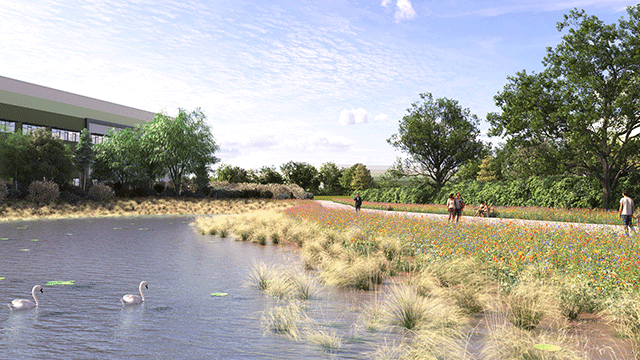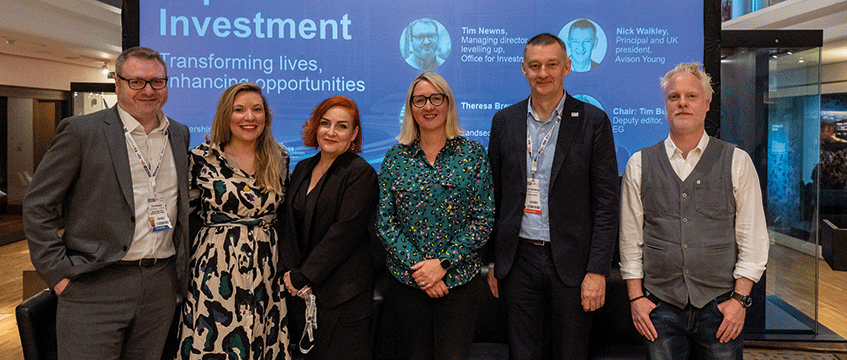Hanging baskets in public realms and chessboards in parks. Nick Walkley is no fan of either when it comes to transforming space in towns and cities. For the principal and UK president of Avison Young, they’re the kind of tick-box ideas that let local authorities and some developers say their scheme has delivered good to the local community.
That plays into a worrying challenge for real estate, Walkley told the audience at EG’s panel on impact investing at the UKREiiF conference in Leeds last month – how to ensure a focus on social value isn’t lost during a tough time for investors and developers.
“There is a danger in this really challenging political and economic environment, where it’s really hard to get deals across the line, that social value becomes the most impermanent thing in a series of permanent moves,” Walkley said. “It’s chess sets in parks versus assets that are going to be there for generations. I think where we’re moving to at this inflection point is that more investors and owners are realising that if you don’t hardwire social value in at a very early stage, you’re going to be left with a stranded asset. The post-Covid era is one where amenity matters, not just to communities but to occupiers and investors. Social value for me is about how we tap into the meaning of a building and the meaning of a place.”
Scale of ambition
At LandsecU+I, fellow panellist Theresa Brewer, development director, believes the company has done exactly what Walkley recommends – hardwiring social value in at the start of a project by taking the conversation direct to the local community.
“LandsecU+I have long considered themselves as being different. We like to break the rules,” she said. “We like to think about the communities we work in and start there. For too long the development sector in particular has had a bad reputation for thinking just about our shareholders and our profits. We like to start from the fact that of course you need to make a profit in order to be able to develop something, but equally important are the social and environmental factors. Whenever we get a new site, we start with the social impact first. We like to get to know the communities we’re working in, we like to ensure we create a really strong research and database. But, most importantly, we like to speak to the people who know what’s going on.”
A name such as Landsec tends to be linked to a city’s largest schemes, the kind of landmark regeneration projects that attract attention, headlines and capital. But EG’s guests were adamant that the real estate industry and the public sector must do more to make sure that lessons can be taken from those projects to what Kellie Hatton, partner and co-head of development at law firm Shoosmiths, calls “the other 90%”.
“A lot of local authorities focus on those flagship schemes, and that is right because they’ve got a finite number of resources,” she said. “But what I’m interested in seeing is how do you take those exemplar schemes, the 5% or 10%, and then roll them out at scale for the rest of the city or location?”
Based in Sheffield, Hatton pointed to the ongoing work in the city centre, including L&G’s £300m West Bar Square scheme. The projects are stellar, she said, but she wants public and private players to “be bold, be brave”, and do more.
“Sheffield city centre is going great guns at the moment,” Hatton said. “They’ve got tons of funding from Homes England, a big scheme with L&G… but that’s a tiny part of the city centre. Big applause for getting that done, but how do we then get L&G to do five schemes in Sheffield? Scale of ambition is important and scale on the ground as well. We’ve all seen developments where it is just a single building and it can be very formulaic.”
Money talks
Tim Newns, managing director for levelling up at the Office for Investment, agreed on the need to be bold. But the flow of funding for regeneration hasn’t always allowed for that, he acknowledged.
“Some of the funds that have come through from government over the past few years, although well intended, have had the unintended consequence that it’s drawn councils, local authorities and combined authorities into slightly more tactical propositions,” he said. “You’ve got multiple funds coming in at maybe £20m on average, then some of the activities like taking a single shopping centre asset [and redeveloping it]. It will have local impact but it won’t have transformational impact on the area. How do we get places and government to look at bigger, bolder projects?”
Julie Nugent, chief executive of Coventry City Council, knows that, for some local authorities, it will take a rethink of how their entire organisation links up, drawing better connections between departments that ensure the right schemes of the right size are able to have the right impact.
“One of my objectives as a relatively new chief exec is to get rid of some of the siloed working, because often planning works in its own little world, disconnected from our children’s services, disconnected from our housing teams,” she said. “When I look at what fills my inbox, from councillors and residents, it’s potholes, obviously, but also some of things that have gone wrong with planning and where people feel they have been let down.”
She pointed to the 1,500-home City Centre South project the council is working on with Shearer Property Group. It is one of the largest real estate developments the city has seen in decades, she said, and is due to kick off later this year. There is no possibility that any of the parties involved want to risk that scheme letting locals down.
“We have to get it right for our communities,” Nugent said. “People will judge us, and rightly so.”
The experts
- Theresa Brewer, development director, LandsecU+I
- Kellie Hatton, partner and co-head of development, Shoosmiths
- Tim Newns, managing director for levelling up, Office for Investment
- Julie Nugent, chief executive, Coventry City Council
- Nick Walkley, principal and UK president, Avison Young
Image © JMA Photography
In partnership with
Send feedback to Tim Burke
Follow Estates Gazette












